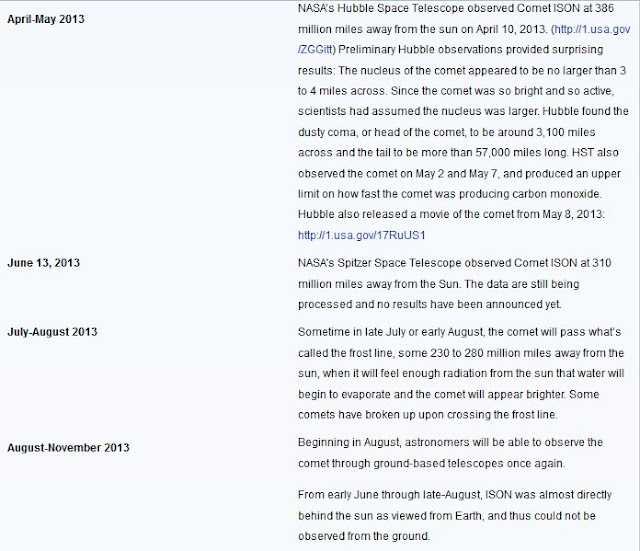
NASA - STEREO Mission patch / NASA / ESA - Hubble Space Telescope patch.
July 17, 2013
Video above: Comet ISON, which will round the sun on Nov. 28, 2013, at a distance of just 730,000 miles from the sun, is what's known as a sungrazing comet, due to its close approach. Video Credit: NASA/Goddard Space Flight Center.
A comet’s journey through the solar system is perilous and violent. A giant ejection of solar material from the sun could rip its tail off. Before it reaches Mars -- at some 230 million miles away from the sun -- the radiation of the sun begins to boil its water, the first step toward breaking apart. And, if it survives all this, the intense radiation and pressure as it flies near the surface of the sun could destroy it altogether.
Right now, Comet ISON is making that journey. It began its trip from the Oort cloud region of our solar system and is now travelling toward the sun. The comet will reach its closest approach to the sun on Thanksgiving Day -- Nov. 28, 2013 -- skimming just 730,000 miles above the sun’s surface. If it comes around the sun without breaking up, the comet will be visible in the Northern Hemisphere with the naked eye, and from what we see now, ISON is predicted to be a particularly bright and beautiful comet.
Image above: Predicted hour-by-hour position of Comet ISON in various instruments on one of NASA’s Solar Terrestrial Relations Observatory spacecraft between 1 a.m. EST on Nov. 26, 2013, and 7 p.m. EST on Nov. 29, 2013. The blue field of view is from the outer coronagraph and green from the inner coronagraph. Image Credit: NASA/STEREO/Goddard Space Flight Center.
Cataloged as C/2012 S1, Comet ISON was first spotted 585 million miles away in September 2012. This is its very first trip around the sun, which means it is still made of pristine matter from the earliest days of the solar system’s formation, its top layers never having been lost by a trip near the sun. Scientists will point as many ground-based observatories as they can and at least 15 space-based assets towards the comet along the way, in order to learn more about this time capsule from when the solar system first formed.
Even if the comet does not survive, tracking its journey will help scientists understand what the comet is made of, how it reacts to its environment, and what this explains about the origins of the solar system. Closer to the sun, watching how the comet and its tail interact with the vast solar atmosphere can teach scientists more about the sun itself.
Image above: Hubble's view of Comet ISON (C/2012 S1) on April 10, 2013. This image was taken in visible light. The blue false color was added to bring out details in the comet structure. Image Credit: NASA, ESA, J.-Y. Li (Planetary Science Institute).
NASA has initiated a Comet ISON Observing Campaign to facilitate a massive global observation campaign incorporating both space-based and ground-based telescopes and encouraging citizen scientists and both professional and amateur astronomers to participate.
Read on for a timeline of observations expected of Comet ISON on its perilous journey.
Related Links:
More on the Comet ISON Observing Campaign: http://www.isoncampaign.org/
NASA’s Comet ISON Toolkit: http://solarsystem.nasa.gov/ison/
Images (mentioned), Video (mentioned), Text, Credits: NASA's Goddard Space Flight Center / Karen C. Fox.
Best regards, Orbiter.ch



+on+April+10,+2013.jpg)





